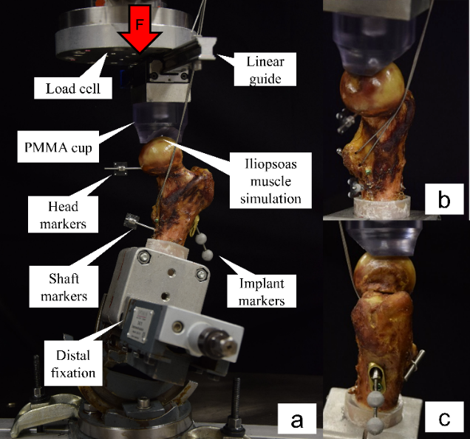Biomechanical evaluation of femoral neck fracture fixation with the Femoral Neck System in comparison to the Hansson Pin system (FNSHansson)
Background
Femoral neck fractures account for half of all hip fractures and are recognized as a major public health problem associated with a high socioeconomic burden. The recently introduced implant Femoral Neck System (FNS) was developed for dynamic fixation of femoral neck fractures and provides angular stability in combination with a minimally invasive surgical technique. Alternatively, the Hansson Pin System (HPS) with two parallel pins exploits the advantages of internal buttressing. However, the obligate peripheral placement of the pins renders the instrumentation more challenging. So far, it has remained unclear which fixation system provides higher biomechanical stability.
Goal
To evaluate the biomechanical performance of FNS versus HPS in a Pauwels II femoral neck fracture model with simulated posterior comminution.
Results
Forty-degree Pauwels II femoral neck fractures (AO 31-B2.1) with 15° posterior wedge osteotomy were simulated in 14 paired fresh-frozen human cadaveric femora, followed by instrumentation with either FNS or HPS in pair-matched fashion. Implant positioning was quantified by measuring the shortest distances between implant and both inferior (DI) and posterior (DP) cortex on anteroposterior and axial X-rays. Biomechanical testing was performed in 20° adduction and 10° flexion of the specimens in a novel setup with simulated iliopsoas muscle tension. Progressively increasing cyclic loading was applied until construct failure. Interfragmentary femoral head-to-shaft movements, namely varus deformation, dorsal tilting and rotation around the neck axis were measured by means of motion tracking and compared between the two fixation groups. In addition, varus deformation and dorsal tilting were correlated with DI and DP. From a biomechanical perspective, by providing superior resistance against varus deformation and being less sensitive to variations in implant placement, the angular stable Femoral Neck System can be considered as a valid alternative to the Hansson Pin System for the treatment of Pauwels II femoral neck fractures.
-
Publications
Schopper C, Zderic I, Menze J, Müller D, Rocci M, Knobe M, Shoda E, Richards RG, Gueorguiev B, Stoffel K. Higher stability and more predictive fixation with the Femoral Neck System versus Hansson Pins in femoral neck fractures Pauwels II. J Orthop Translat. 2020;24:88-95
-
Presentation
Schopper C, Zderic I, Menze J, Müller D, Rocci M, Knobe M, Shoda E, Richards RG, Gueorguiev B. Better stability and more predictive fixation of the Femoral Neck System versus two Hansson Pins in Pauwels II femoral neck fractures – a biomechanical study. 2019 EORS (oral)
-
Partner
Stoffel K (Prof), University Hospital Basel, Basel, Switzerland
Sommer C (MD), Cantonal Hospital Graubuenden, Chur, Switzerland
Müller D, Menze J, DePuy Synthes, Zuchwil, Switzerland


